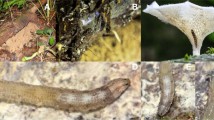Abstract
A PRELIMINARY study of the effects of thyroid gland tablets on Amœba proteus, placed singly or in bulk in hollowed-out glass squares, having been made without any definite results, the whole of the resulting material was used for inoculating culture 12, boiled wheat grains being the pabulum. For many months the pH of this culture fluctuated around pH 4, and Euglena flourished. Bean and pea cotyledons were substituted as pabulum. Small amœbæ, length 10–20 µ, were now present in culture 12. Miguel's fluid was added and the pH rose to pH 6.2. After a few months had elapsed, adult A. proteus appeared, and culture 12 was so flourishing that it was divided up into sub-cultures. These cultures are readily distinguished from our stock cultures even by a biologist quite ignorant of their history by: (1) the larger size of the adult amœbæ in them, (2) the persistence of the adult stage beyond the normal span (the time occupied by the amœbæ to grow from newly hatched to sporulation stage is twelve months); and, therefore, (3) the rarer occurrence of developmental stages in the culture; (4) difficulty in making successful sub-cultures from the original.
This is a preview of subscription content, access via your institution
Access options
Subscribe to this journal
Receive 51 print issues and online access
$199.00 per year
only $3.90 per issue
Buy this article
- Purchase on Springer Link
- Instant access to full article PDF
Prices may be subject to local taxes which are calculated during checkout
Similar content being viewed by others
Author information
Authors and Affiliations
Rights and permissions
About this article
Cite this article
TAYLOR, M. Effect of Thyroid Gland on the Cultivation of Amœba proteus. Nature 171, 313–314 (1953). https://doi.org/10.1038/171313b0
Issue Date:
DOI: https://doi.org/10.1038/171313b0
Comments
By submitting a comment you agree to abide by our Terms and Community Guidelines. If you find something abusive or that does not comply with our terms or guidelines please flag it as inappropriate.



